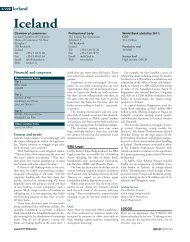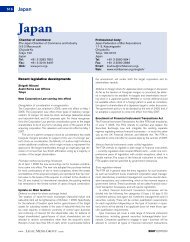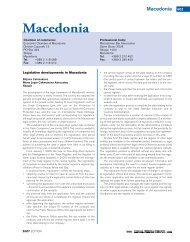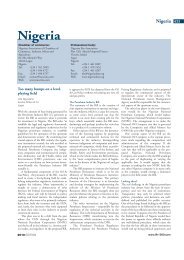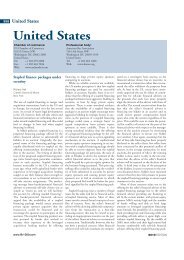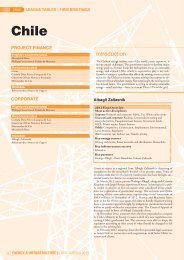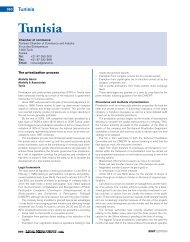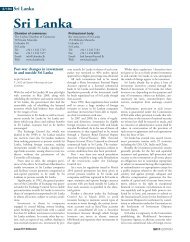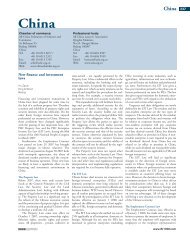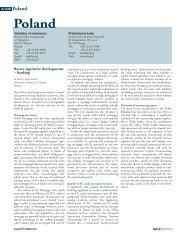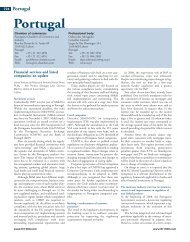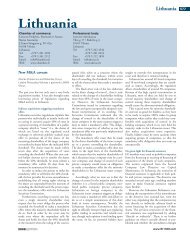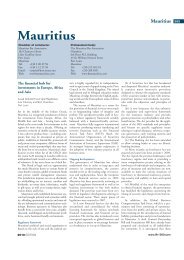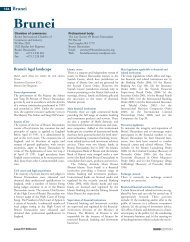Canada - IFLR1000
Canada - IFLR1000
Canada - IFLR1000
Create successful ePaper yourself
Turn your PDF publications into a flip-book with our unique Google optimized e-Paper software.
138<br />
<strong>Canada</strong> | Banking<br />
sation simplifies transaction teams and decreases<br />
the ever-important costs of staffing a file. The<br />
work produced by the model speaks for itself.<br />
Representing a syndicate consisting of RBC<br />
(Royal Bank of <strong>Canada</strong>), TD Bank (Toronto-<br />
Dominion Bank), Scotiabank, BMO (Bank of<br />
Montreal), CIBC (Canadian Imperial Bank of<br />
Commerce) and National Bank of <strong>Canada</strong>,<br />
McCarthy negotiated the underwriting agreements<br />
behind Manulife Financial’s December<br />
2008 equity offering. Executed as a bought<br />
deal, the public offering raised $1 billion in tandem<br />
with a simultaneous $1.1 billion through a<br />
separate private placement. McCarthy also<br />
arranged $3 billion in lending facilities through<br />
the same syndicate for Manulife.<br />
As issuers’ counsel, McCarthy represented<br />
TD Bank in September 2008. Through the<br />
TD Capital Trust III, McCarthy engineered<br />
the issue of $1 billion in securities. Later in<br />
the year, the firm advised BMO in a highyield<br />
issuance worth C$450 million. Due in<br />
2017, the notes provided Tier 1 capital for the<br />
bank at the height of the economic downturn.<br />
Leading lawyers<br />
Richard Balfour<br />
Jean Michel Deschamps<br />
Byran Gibson<br />
J Michael McIntosh<br />
Robert Metcalfe<br />
Barry Ryan<br />
For analysis of the other leading law firms in<br />
<strong>Canada</strong>’s capital markets please visit the<br />
website at www.iflr1000.com<br />
Bank lending<br />
Recommended firms<br />
Tier 1<br />
Blake Cassels & Graydon<br />
McCarthy Tétrault<br />
Osler Hoskin & Harcourt<br />
Tier 2<br />
Davies Ward Phillips & Vineberg<br />
Goodmans<br />
Stikeman Elliott<br />
Tier 3<br />
Bennett Jones<br />
Borden Ladner Gervais<br />
Fasken Martineau<br />
Ogilvy Renault<br />
Torys<br />
Tier 4<br />
Burnet Duckworth & Palmer<br />
Fraser Milner Casgrain<br />
Macleod Dixon<br />
McMillan<br />
www.iflr1000.com<br />
Financial services regulatory<br />
Recommended firms<br />
Tier 1<br />
Blake Cassels & Graydon<br />
McCarthy Tétrault<br />
Osler Hoskin & Harcourt<br />
Torys<br />
Tier 2<br />
Fasken Martineau<br />
Ogilvy Renault<br />
Stikeman Elliott<br />
Tier 3<br />
Borden Ladner Gervais<br />
Fraser Milner Casgrain<br />
Goodmans<br />
The absence of subprime mortgage investment<br />
exposures and a history of conservative<br />
management have saved many Canadian<br />
financial institutions from the losses suffered<br />
in the US. But the contagions of fear and misperception<br />
still pose a hurdle, even in <strong>Canada</strong>.<br />
While transactional work has suffered, the<br />
need for regulatory advice remains consistent<br />
in the jurisdiction. “Banking has actually been<br />
a bright spot. Transactions are off across the<br />
board, but, fortunately, Canadian banks are<br />
relatively strong and can be acquirers,” says a<br />
partner. Following a flurry of recapitalisation<br />
transactions in the capital markets, many<br />
Canadian financial institutions now find<br />
themselves in an advantageous position. The<br />
question now is whether they will alter the<br />
business model that has prevented loss in<br />
order to improve post-recession market share.<br />
Banking and finance partners in <strong>Canada</strong><br />
say they began noting the pullback of foreign<br />
financial institutions from the US and Europe<br />
as early as the spring of 2008. The speculation<br />
then, much as it is now, is whether <strong>Canada</strong>’s<br />
prominent investment banks and insurance<br />
companies will try to fill the void. “Who<br />
knows, it may be the rebound of the investment<br />
banks in <strong>Canada</strong>,” says one partner.<br />
“What we’ve seen previously is a gradual erosion<br />
of the Canadian investment banks to<br />
large American banks like JPMorgan, Bank of<br />
America, and Citi. Maybe since those guys are<br />
hiccupping at the moment, we’ll see the<br />
Canadian investment banks re-establish<br />
themselves.”<br />
This potential re-development of the<br />
domestic financial sector is already causing<br />
some ripples in the legal community as well.<br />
As the banks examine the events of the past<br />
year, and the legal advice they received, some<br />
Canadian counsel see a shake-up of the historic<br />
relationships that have come to define<br />
some firm’s finance departments.<br />
The prospect of any regulatory change in<br />
<strong>Canada</strong> is doubtful thanks to the financial sector’s<br />
limited subprime exposure. In fact, many<br />
see the Canadian system as a working model<br />
for the regulatory overhauls under discussion<br />
elsewhere in the world. This has allowed<br />
lawyers here a tempered optimism as firms<br />
find their corporate departments posting better-than-expected<br />
results through early 2009.<br />
“We essentially have been busier than ever in<br />
financial services, mainly because our clients<br />
and all the banks and insurance companies<br />
have been busy building capital,” says a partner.<br />
Blake Cassels & Graydon<br />
Blakes has engineered an enviable banking<br />
group, with a strong team that includes Kevin<br />
Fougere, Michael Harquail, Dawn Jetten and<br />
senior counsel James Christie. “I use Blakes<br />
exclusively,” says a client. “I use them for securities<br />
work and they’re very effective for that.”<br />
The firm’s client list includes a mix of foreign<br />
and domestic financial institutions, such as<br />
JPMorgan and the CIBC (Canadian Imperial<br />
Bank of Commerce).<br />
In fact, JPMorgan recently sought Blakes’<br />
counsel in connection with their involvement<br />
in Teck Cominco’s acquisition of the Fording<br />
Canadian Coal Trust. Representing a syndicate<br />
led by JPMorgan, Blakes was able to construct<br />
a $4 billion senior term loan facility and<br />
a $5.8 billion senior bridge facility as part of<br />
an overall $14 billion financing package. The<br />
transaction was closed in October 2008.<br />
As part of the simultaneous rights offering<br />
and private placement of debentures for<br />
TimberWest Forest Corp, Blakes advised the<br />
arranger and syndicate negotiating changes to<br />
the issuer’s underlying credit facilities. Under<br />
Blakes’ counsel, the BMO Capital Markets<br />
and Rabobank Nederland-led syndicate<br />
amended TimberWest’s existing loan agreements,<br />
including the instalment of a new<br />
$250 million three-year revolving credit facility.<br />
Again in the forestry sector, the firm<br />
advised borrower Ainsworth Lumber on a<br />
recapitalisation programme in which Blakes<br />
negotiated the exchange of $824 million in<br />
debt for equity and $150 million in new unsecured<br />
notes. A new series of notes was also<br />
issued, equalling $200 million, and three<br />
credit facilities of equal worth were amended.<br />
Leading lawyers<br />
James Christie<br />
Martin Fingerhut<br />
Kevin Fougere<br />
Dan Fournier<br />
Michael Harquail<br />
Dawn Jetten<br />
2010 EDITION



